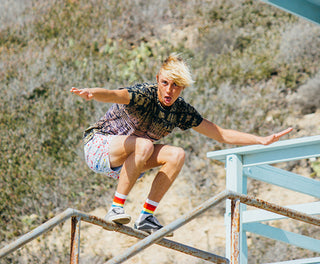Surfwear brand Mowgli Surf is run by a pair of very strange twins that want to change the world. “I just want to make the world more beautiful,” says Philip Seastrom, one half of the pair. He, along with his identical twin brother Alex Seastrom make wildly beautiful handcrafted (hand-dyed, hand-painted, hand-stamped, etc.) garments all made in the US that dare to challenge the way we think about contemporary surfwear; and really – stale, dark, neutral apparel as a whole.
The Mowgli Surf twins’ aesthetic is marked by a distinct use of color and print. They even describe their creations as “challenging” in their site bio, along with this gem: “If you want to be like everybody else, you have come to the wrong place.” This unabashed stance on individual style has lent itself to their bold designs and even bolder opinions: The Seastrom brothers want men’s shorts to be shorter; they actually had a knit semi-proto-jogger silhouette in 2010 that no one in their industry understood at the time; their Spring ’15 line incorporates craftmanship like hand-sprayed tartan; Alex says he gives people unsolicited advice constantly; and Mowgli is 150% about mixing prints.
I had heard that the twins behind Mowgli Surf were eccentric, but nothing could have prepared me to meet Philip and Alex at the Gene Autry Western Heritage museum, where they proposed we conduct our interview. The two filled me in on their intensive knowledge of Western art (but mostly we just had too much fun) and their love for the ornate expressiveness of Western-era apparel: “Just as an art form, Western art knows what it is,” says Philip. I quickly learned that Mowgli Surf also knows exactly what it is. And in our interview below, Alex and Philip discuss what propels them to go against the grain; and why they work so hard to promote the beautiful, the expressive, and the individual through everything they do.
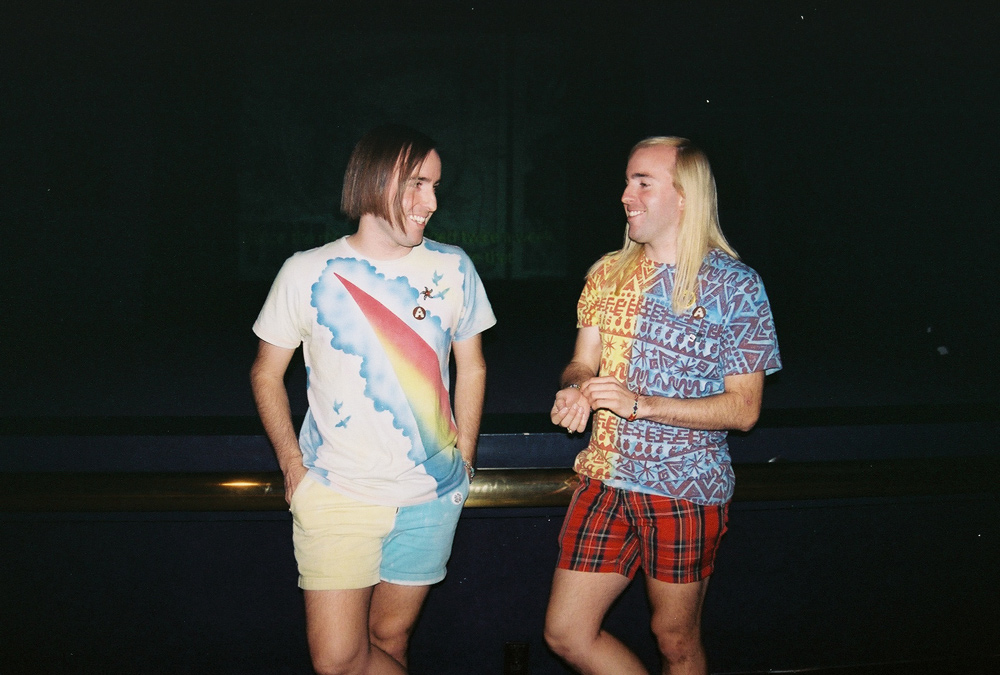
Left: Alex, Right: Philip.
ALINA: So you guys are twins and you’re perfectionists.
ALEX: Since birth.
Do you want to introduce yourselves and also say your full, crazy long name?
ALEX: I’m Alexander Seastrom Probandt.
PHILIP: I’m Philip Seastrom Probandt.
Alex: Oh, Alexander John Seastrom Probandt.
Philip: Philip Hadden Seastrom Probandt.
You guys have been interested in having your own apparel brand for a really long time, right? Since when?
Alex: I don’t know, probably when we were in 7th or 8th grade. We used to make skateboards and try to sell them on Ebay and paint skateboards.
Philip: Yeah, we had our own little skateboard deck line that no one ever bought. Some guy emailed me once and was like, “Hey, you go down on the shipping?” I was like, “Sure.” And then he never bought it and I was like, “Oh, bummer.”
Alex: I think we actually did sell one. My sister drew some naked girl on a skateboard and that, of course, sold.
When did you guys graduate from an interest in skate into having an interest in surfwear?
Alex: When I was in high school. We were really into surfing… We’re from La Cañada, which is in the San Gabriel Valley right up against the mountains, and there are two surf shops in our town. I always thought it was really cool and the kids that surfed I thought were really cool. When we were young, we didn’t have much money, so we’d only shop at Mervyn’s. I always wanted to wear Quiksilver and Pac Sun [Laughs]. My mom would be like, “No, we can’t go there.” So when I got older I got a job. I’d only buy surf clothes with all my money.
And I’d buy T-shirts and I wouldn’t wear them for six months so no one else would have them. Now, I think it’s cool, if I see someone wearing the same shirt as me I’ll be like, “Twins! High five!” But back when you were young and dumb you’re like,” Oh, my individuality!”
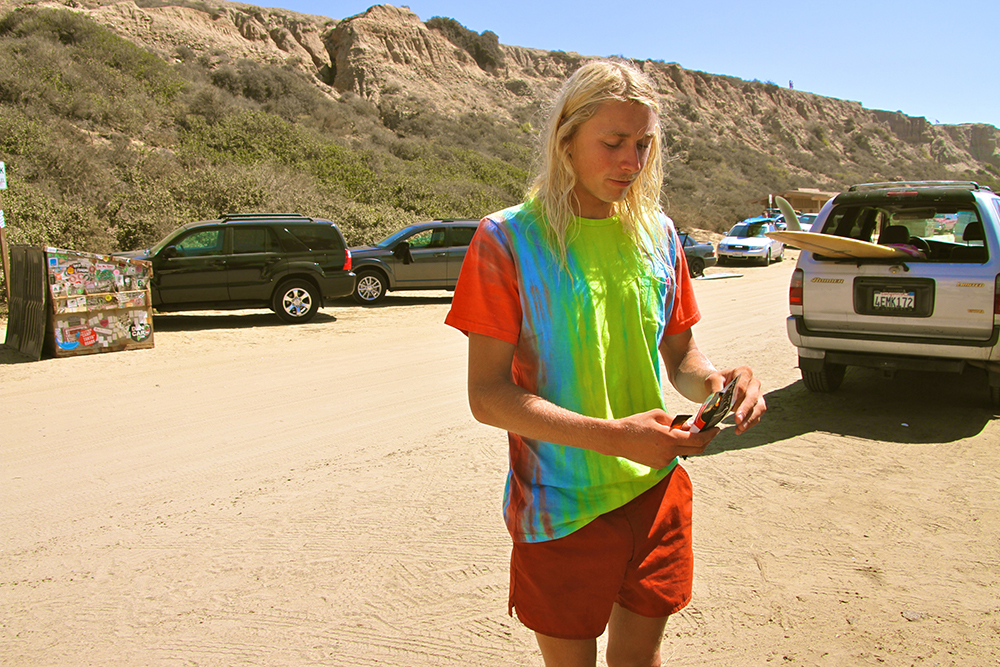
It sounds like you guys have always been really into clothing then.
Philip: Yeah, we’ve always been really into clothing. My mom made clothes back then when the craft fairs were really big in the early ‘90s, [she] made hand-painted T-shirts.
The craft fairs! What happened to them?
Alex: This is what my mom says: Everyone back in the day had these T-shirts and they’d glue Rosettes on them, which are those little flower things. So they glued them all, paint them, and make them all cool. They’d sell them for like $35 each. This was 1992. $35 for a T-shirt is a going rate now, but back then that was crazy. Then Target and all the big retailers got wind of the craft fair because it was a booming sub-culture in that point in time for moms in the early and mid ‘90s. They started copying the design so they’d have the same shirt for $10.
Philip: So people stopped going to craft fairs. It’s kind of like the weirdness of how comedy clubs were killed by Comedy Central. You think that would make comedy more popular, but putting it on TV made people not go to comedy clubs anymore. They’re like, “Oh, I can just watch Comedy Central, I don’t need to go anymore.”
“I don’t even need to leave my house! Why would I leave my fucking house?” Do you guys think that your interest in apparel started with your mom?
Alex: That’s part of it for sure. That’s part of the rich tapestry. Then I always felt that clothing is how people want the outer world to see them as a person. So the way you dress is how you want the world to perceive you, and I felt like there was nothing out there that really was me and was for someone like me that was fun and colorful and bright.
Philip: That’s one of the reasons I really got into it. It’s just a way to express yourself to the world.
“THE LEAST REBELLIOUS THING YOU COULD DO TODAY IS WEAR ALL BLACK.”
So Philip, you studied ceramics and Alex, you studied art. Then you both went to FIDM for [Apparel Manufacturing and immediately started Mowgli]?
Both: Right away.
You guys knew so much about everything in the [Gene Autry Museum]. You were like, “Oh, yeah this is by that artist.” I was like, “Whoa.”
Philip: I really like Western stuff, we’ve always been a big fan. The Western aesthetic is very beautiful and the clothing is very ornate and fun and very expressive. Just as an art form, Western art knows what it is.
You’re both really into expression.
Both: Yeah.
You’re also perfectionists.
Philip: [Sarcastically] Gotta express yourself perfectly.
Alex: The reason why we chose the name Mowgli was because Mowgli’s the main character of The Jungle Book. And we thought that Mowgli’s character, his youth, his wildness, and his personality really embodied surfing… as a culture, I suppose.
Philip: He’s like this wild guy raised by wolves. It’s really exciting, I think Mowgli is an exciting name. Especially because the books are so good.
Alex: It’s like an untamed existence.
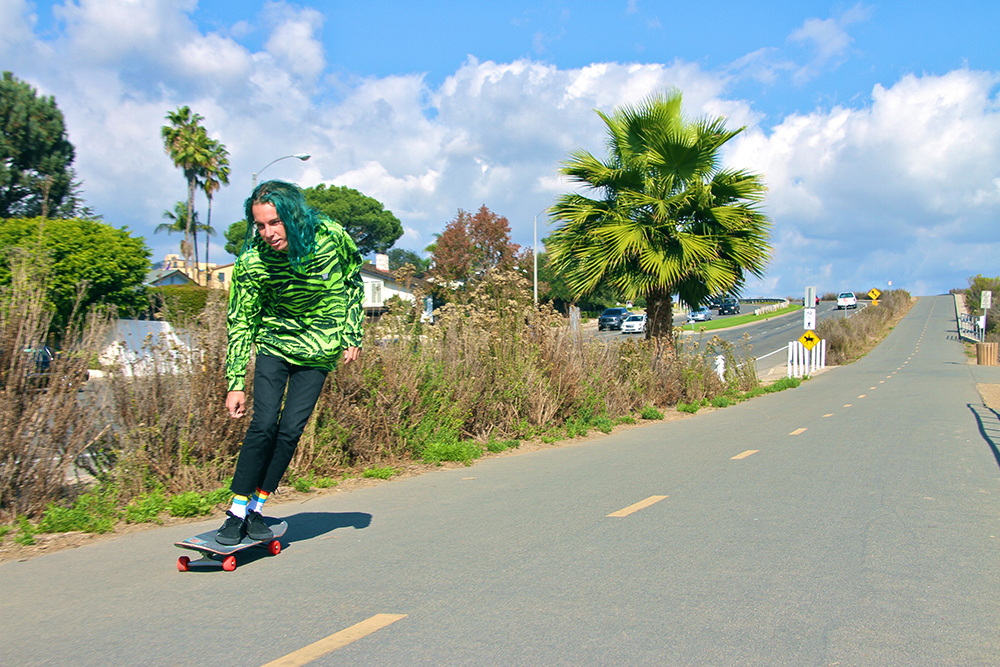
I read you guys say in another interview that the state of surfwear is kind of boring now.
Alex: It’s getting much, much better. Surfwear has come so far since 2009.
Philip: It’s still not great.
Alex: But it’s not just black anymore. There’s lots of cool, new companies like Critical Slide Society, Brothers Marshall, Plate Lunch, Salt Surf, lots of cool new companies that have good voices. You still have lots of this bro-y stuff.
Philip: It’s the companies as a whole, especially the major companies, they’re just very stagnant and they just do the same thing over and over again and make the same logo T and make the same color palette and make the same ugly long shorts. It’s just so inauthentic and so stupid and so dark. I just don’t get it. If I were shopping in the stores, I wouldn’t buy any of that stuff – any of the major companies’ stuff at all, it’s terrible.
When you say dark, what do you mean?
Philip: Like physically dark, it’s black.
Alex: I don’t mean goth, because I could be into that – that’s cool because that’s its own thing. But I mean a black T-shirt that just says Hurley on it. It’s all so masculine, all so pseudo-masculine.
“THE PROBLEM IS WE’RE BOTH PERFECTIONISTS SO IT SPIRALS OUT OF CONTROL SOMETIMES.”
Philip: “We are men, look at my logo T that says Hurley on it, dawg.” I get it.
Earlier, when I asked you guys what you’re interested in [and] what you hope would be more popular, you were saying “shorter shorts.”
Alex: Oh, for sure.
So that isn’t in line with that masculinity of popular surfwear.
Alex: That’s all proposed masculinity. It’s what society thinks is manly.
Shorter shorts were super masculine in the ‘80s.
Philip: I don’t get it, it’s better.
Alex: And I’m not talking 1979 Lakers shorts, I’m talking just three or four inches above the knee. Nothing too crazy.
Philip: I prefer them higher than that, but the public could go three or four inches above the knee. I prefer them to be mid-thigh, I think that’s perfect.
Alex: And I want men just to dress in more color. Philip and I were talking about this the other day, and back in – if I understand this correctly, back in the ‘50s or ‘60s – Johnny Cash was considered a rebel because he wore all black. The least rebellious thing you could do today is wear all black.
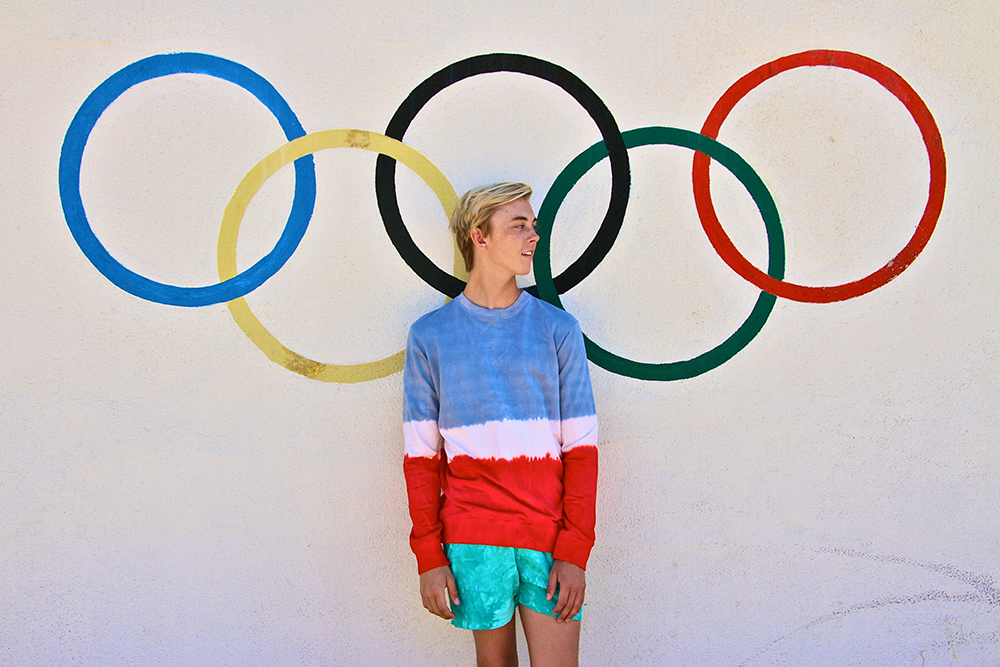
So Mowgli’s been around since 2010 and you’re about to get a studio space in 2015. What have been the greatest challenges and greatest victories for you with the brand so far?
Alex: I would say some of the greatest challenges [are] money-related. Lots of financial challenges, huge financial challenges. You think if you start a brand and get sales and stuff, people would be lining up to – I don’t want to say invest – but to help you out. If you get a bunch of orders you should be able to easily get a bunch of money to boost the product, to finance it, but it’s so hard. Unless your parents are signing over their house for you to make money. If you don’t start with money or the connections to money, it’s a nightmare.
Philip: My financial situation was always very tenuous [laughs].
How do you guys deal with that stress? And how have you guys gotten to get over that hump?
Alex: Just deal with it. You find people to give you bridge loans to produce product and then you pay them back after the product’s made. But one problem we have now is with expansion, I can only be so big. Not that I’m trying to be Guess Jeans or something.
Philip: If someone writes me a million dollar PO I’m like, “Thanks for the million dollar PO, bro. I can’t do anything with it.” I could put this on my shelf and it’ll look pretty, but how am I going to get the $500,000.
“I WANT TO DESIGN THINGS THAT HELP PEOPLE EXPRESS THEMSELVES.”
What else has been difficult?
Alex: Another thing that’s been really difficult is getting the consumer to understand design.
Philip: That’s probably the biggest. We make a lot of stuff that’s really different and exciting, it’s hard for the consumer to palate a lot of the time. They don’t know what to do with it. Lots of people get it but sometimes – it’s difficult for us beyond just pieces to really do well. But our stuff does really good.
What about your achievements [as a brand]?
Alex: Existing this long.
Philip: That’s 5 years, that’s a big achievement, we’re still in business, we’re still killing it.
Alex: Yeah, we got into a lot of really cool retailers that we work really well with. We’ve been in Thalia, that was our first surf shop we were ever sold in, they’re amazing and we’re still sold there. It’s in Laguna Beach.
Philip: In all the Mollusk shops. They’re a super cool surf shop.
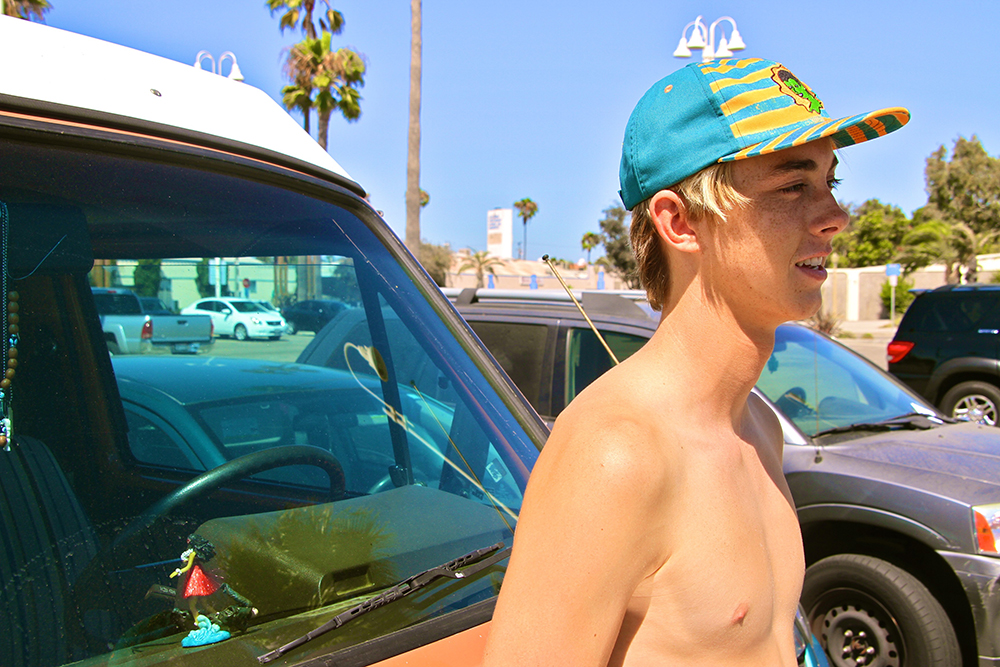
We were talking earlier about how you guys don’t have an e-commerce platform yet. And I think you were saying these days if you don’t sell online, you look irrelevant, but you guys did it because you wanted to support the retailers.
Philip: Back in the day when we started, the Internet was big then but as every year goes by it gets twice as big. I always felt it was more legitimate when we started if you didn’t sell on a web store. Because I thought a web store was small time and it gives stores a reason to buy you. If I’m some small shop, why am I going to buy your stuff if you sell online? All you’re doing is taking business from me, the way I see it. But as it’s gone on, the consumer doesn’t see it that way anymore, not having a web store is a sign of weakness. It’s like, “Why don’t these guys have a web store? Something must be wrong with them. There must be something wrong with their business that they don’t have a web store.”
Back in the day, I thought it was more exclusive and cool if only the store sold it, but that’s not what the consumer thinks. [E-commerce also] allows people to shop the whole look too.
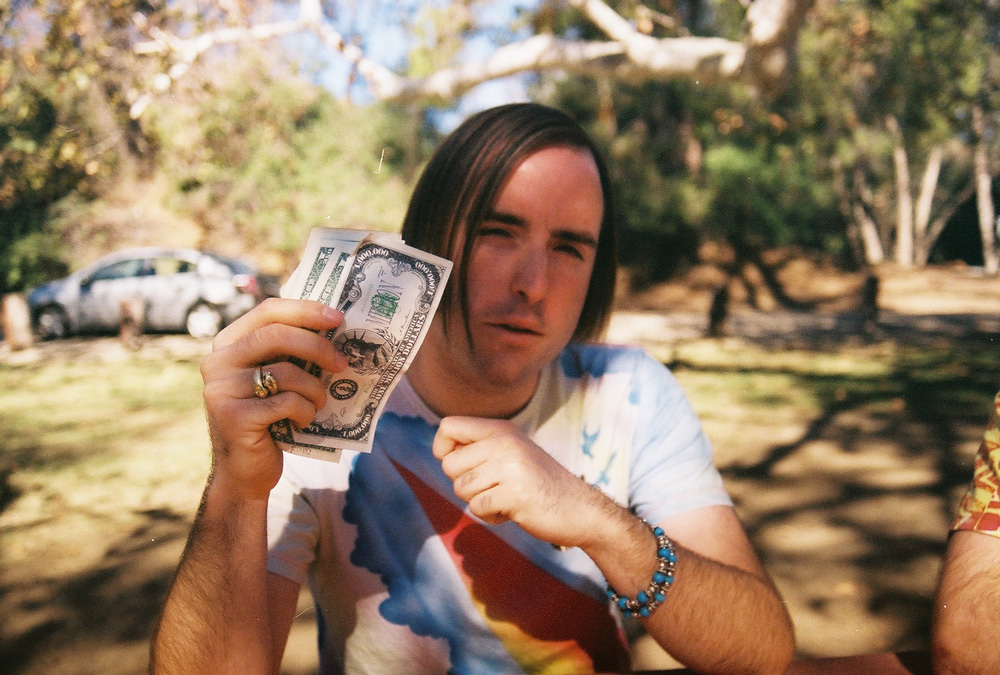
ALEX.
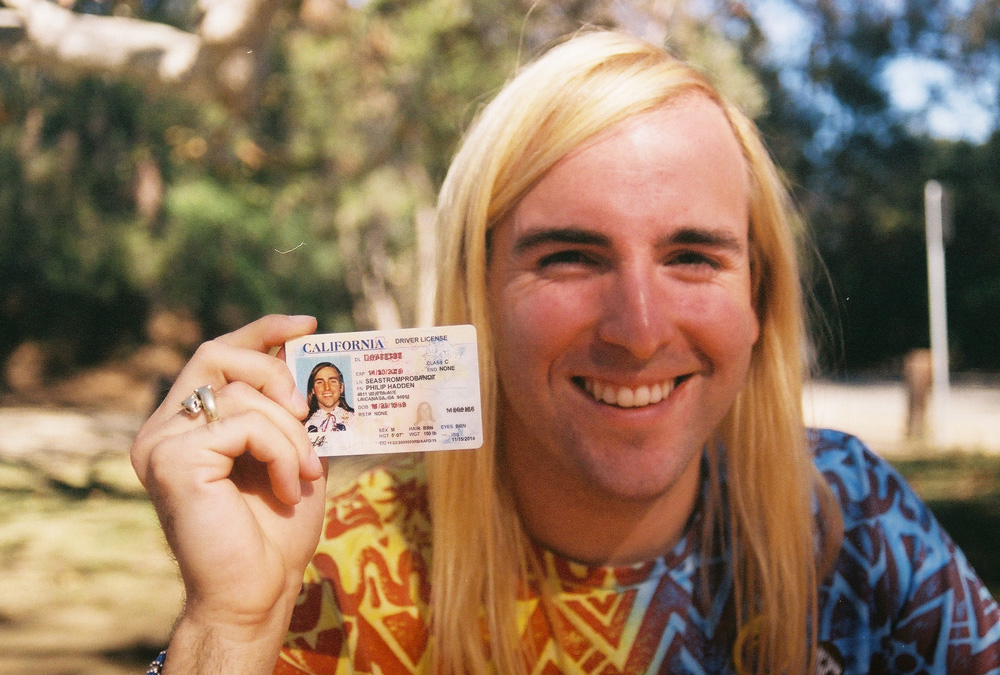
PHILIP.
It must be so interesting being two perfectionist twins working together.
Philip: The problem is we’re both perfectionists so it spirals out of control sometimes. I’ll say one negative comment about something and then he’ll say a negative comment and then we’ll just completely submarine something. We’ll be like, “That looks okay.” I’ll be like, “Oh, I don’t know if I like how that sleeve works.” And he’ll be like, “Yeah, that sleeve’s terrible. We can do better.” I’ll be like, “You know what? That shirt’s horrible, we gotta restart.” Or I’m like, “This is great! This is perfect.” Alex is like, “No!” Or I make a line and I’m like, “Oh, this line’s so good!” And then I’m halfway through selling it and I’m like, “What was I thinking?! Damn you, Summer of 2014!”
You guys also said that oftentimes you’ll create things that are too ahead of its time. Like the jogger story you were telling me – how you guys created a knit pant with a cuff in 2010 and people didn’t really understand how to buy it or wear it. Now joggers are really in.
Alex: We continued making that the whole time and every year, more and more people would buy it. Other people were making jogger-esque product at the time, but not really even close to what it is now.
Philip: People would make comments to us like, “But my ankle’s going to be so tight.” “What do you mean your ankles are going to look tight? It looks terrible, what’re you going to have? An open-ended knit pant? An Abercrombie and Fitch pant? That’s terrible.” Clothes have to conform to your body’s form because your body is beautiful. People like looking at naked people right? You want to emulate that in real life. You want your body’s form to speak for itself, you want the human form to be your voice. That’s what I feel.
“I JUST WANT TO MAKE THE WORLD MORE BEAUTIFUL.”
People didn’t’ get it, they were like, “Why is this not open-ended? It’s going to be uncomfortable.” “Oh, because it looks better.” And they’re like, “But it doesn’t, it’s better open.”
Alex: Spring 2015 is going to be nuts.
Every time you guys roll out stuff I feel like it’s nuts, you’re like, “This is going to be crazy!”
Alex: [Laughs] We’re always trying to make crazy stuff. We’re designing Fall right now and we’re trying to make it super crazy.
What about Spring ’15?
Philip: Spring is really cool, really bright and colorful and fun. Very beach, lots bright colors, cool tie-dyes, tartan shorts, tartan jackets.
Alex: Tartan’s the new bee’s knees. We did this one muscle T that’s tartan.
Philip: But it’s hand-sprayed tartan.
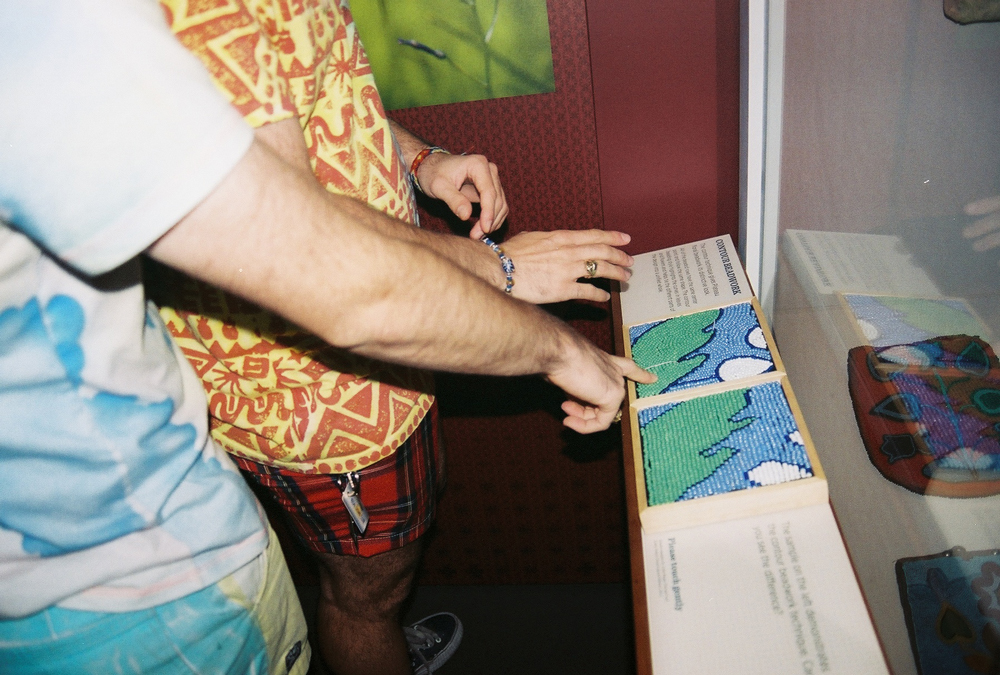
Checking out the beadwork at the Gene Autry museum.
Can you tell us about the hand-dyed and hand-airbrushed processes that you work with?
Alex: One thing we really try to focus on with our design is hand-done processes because we really like the way it looks and feels. All of our clothes are PFD [prepared for dye]. Most companies shy away from premium process because they are very expensive. But I feel the consumer can see the beauty of a hand-done process and see its value.
Philip: I love the look of hand-done tie dyes and airbrush. By each piece being hand-done, each piece is unique. That creates individuality from piece to piece. It’s exciting to me that when you buy a handdone Mowgli product, no one on earth has the exact same shirt as you. It makes the product as individual as the consumer.
Philip: So every T-shirt is white and we go and dye them and get them painted. So it makes a better feel, I think it’s a better aesthetic, and it won’t shrink on you. There’s nothing more frustrating to me, when I was buying clothes, then them shrinking on me. Because you try it on! Why do I even try something on if it’s going to shrink on me? What a big waste of my time. Like I’m going to try a shirt on like, “Oh, this looks great on me.” Then I take it home and it’s a size smaller?
Alex: Then you have people not drying their T-shirts and that’s not what you’re supposed to do with a T-shirt. If you don’t dry your T-shirts, in my opinion, it ages them like crazy. Hanging them stretches them out, the water that you use on them is pretty hard. So if you don’t dry it, all the minerals stay on the shirt and it damages it.
So everything that you guys begin with is a white pre-shrunk T.
Alex: No, it’s white, then it gets pre-shrunk when it’s dyed.
Philip: Shrinkage built into the pattern. That is a struggle by the way. Shrinkage is a nightmare because if you calculate it wrong – the shirt’s supposed to be 27 inches long and it comes in 25 inches and you’re like, “Oh. Okay.” You can have 2,000 T-shirts that you can’t sell if the shrinkage is off. That happened once.
Which season?
Philip: Spring 2013.
Alex: We had to remake all of it.
What’d you do with the rest?!
Alex: You know. It’s in my garage. [Laughs]
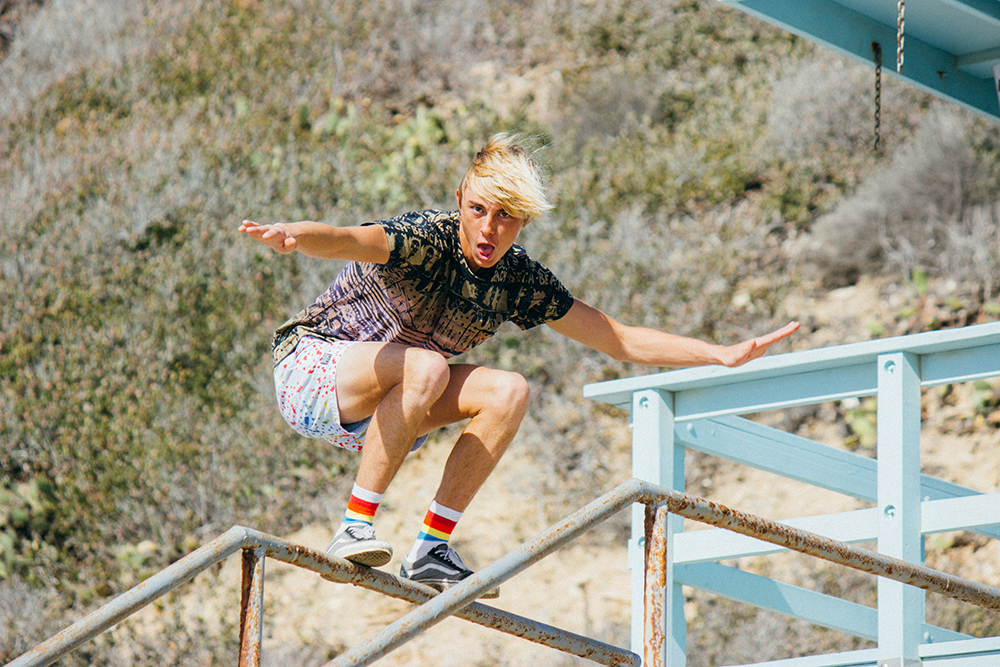
Some brands feel really pressured to come up with a story about the season because people need this inspiring story.
Alex: I feel like our brand is the story.
Philip: Where our minds are at the season we’re designing is all on the same page. I’m not designing it over a year, so we’re on the same page when designing and it all comes out in a similar voice.
Alex: We think of a story but it’s not written down or anything. You look at the pieces and it will tell a story to you mentally. You’ll glean your interpretation of whatever it is, it’s pretty concise.
Philip: But we’re not like, “The paratroopers in the Vietnam War, 1975.”
Alex: Sometimes I’m like, “I want this to look really ‘70s surfer.” I’m just trying to strive to make the perfect season, that’s what I’m trying to do. Every season. But no season is perfect, especially after it comes out.
What kinds of runs do you guys have now?
Alex: It depends, we can make anywhere from 10 to 1,000 of something.
Philip: It depends how hot the style is. We pretty much don’t cancel styles. Because if I make a style, I believe in it and I want it to be out there and I think it’s special. I don’t make 150 styles and cancel half. If I make a piece, it’s because I believe in it, I think it’s worth producing, I think it’s special, and it adds something to the world. I don’t make something just to sell it. Sometimes that’s a mistake.
What do you make it for then?
Philip: I just want to make the world more beautiful.
But in the grander scheme? Why do you guys create and keep going?
Alex: Because I haven’t perfected it, man!
Philip: I want surfing to be what I feel it is in my mind, probably what you feel it is. I feel like it’s this beautiful, youthful existence. Nothing but beaches and fun and hanging out. Just a fun, cool, exciting vibe.
Alex: I want to design things that help people express themselves.
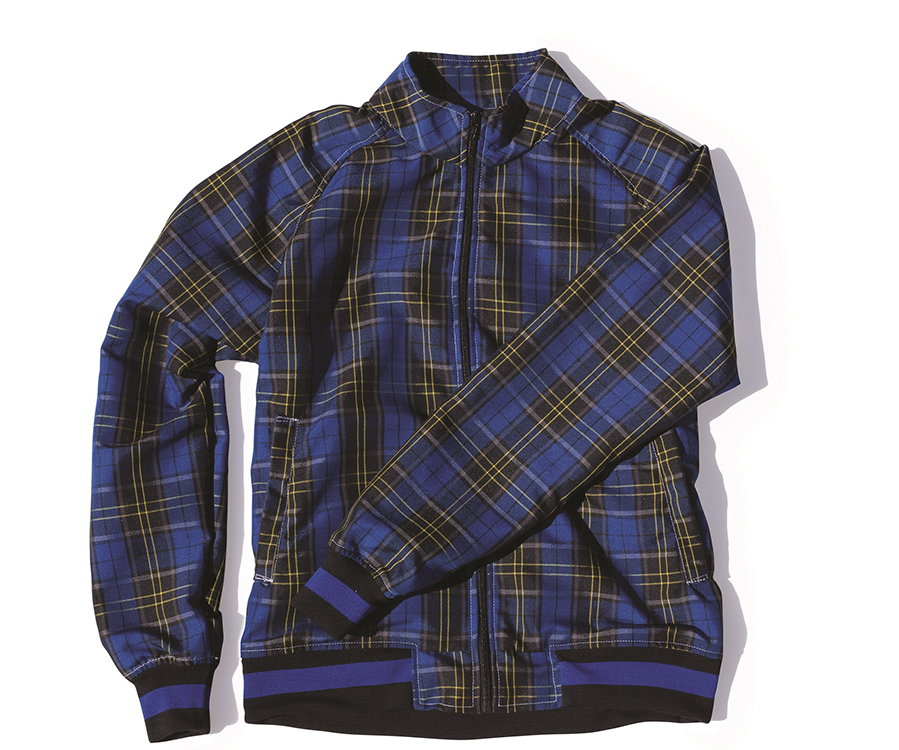
The Mowgli “Holly Rocker” jacket from Spring 2015.
You guys are constantly changing with [what you do] creatively. And it sounds like you’re never 100% happy with what you made or what you came up with.
Alex: I feel like you have to be that way, you can’t ever settle in, that’s how you become stagnant. You settle in like, “This is what people want,” so you make it for – that’s what happened to Billabong. They came out with the same – they figured out what was going on, they had a voice that worked for them, they made that same voice for ten years, same line for ten years, and then people got bored of it and they stopped buying it. Then their sales went down and the problem was they invested in retail locations then they brought their same stagnant voice to all their retail locations. They pumped them full of their products so everything stopped selling. They basically pulled themselves down by having the same design aesthetic for way too long.
Philip: There’s nothing worse than artists who are too satisfied with their work. They’re like, “I printed this ten years ago, this is great.” Then the stuff they’re doing now looks the same or worse. People who settle devolve because they’re just trying to copy what they used to do. That’s super, super, inauthentic – copying yourself. How is that a thing?
“IF I MAKE A PIECE, IT’S BECAUSE I BELIEVE IN IT, I THINK IT’S WORTH PRODUCING, I THINK IT’S SPECIAL, AND IT ADDS SOMETHING TO THE WORLD.”
That reminds me, I forgot to ask you guys about the artists and design collaborations that you do for each season.
Alex: We collaborate with different artists every season for our graphic T’s or different pieces that require artwork. We work with tons of different artists. Mostly, we like to work with artists that all work by hand. Obviously, there’s artwork on computers and stuff, but we feel like there’s a more authentic voice and it has better line work. We work with a lot of different, interesting artists. We worked with Earl Newman, he’s a huge poster artist, he did the Monterey jazz festival posters for the last 53 years.
Philip: Sandy Hoffman, he’s a really great New York artist. He’s really well known because he did this whole commission series for RCA in the ‘60s where he illustrated 150 classical music album covers; it’s crazy. We also use Veronica Fish, she’s a modern artist. She’s a really cool comic book artist based out of the East Coast.
Alex: Jesse Martinez – he is an artist out of Seattle who does a lot of skate.
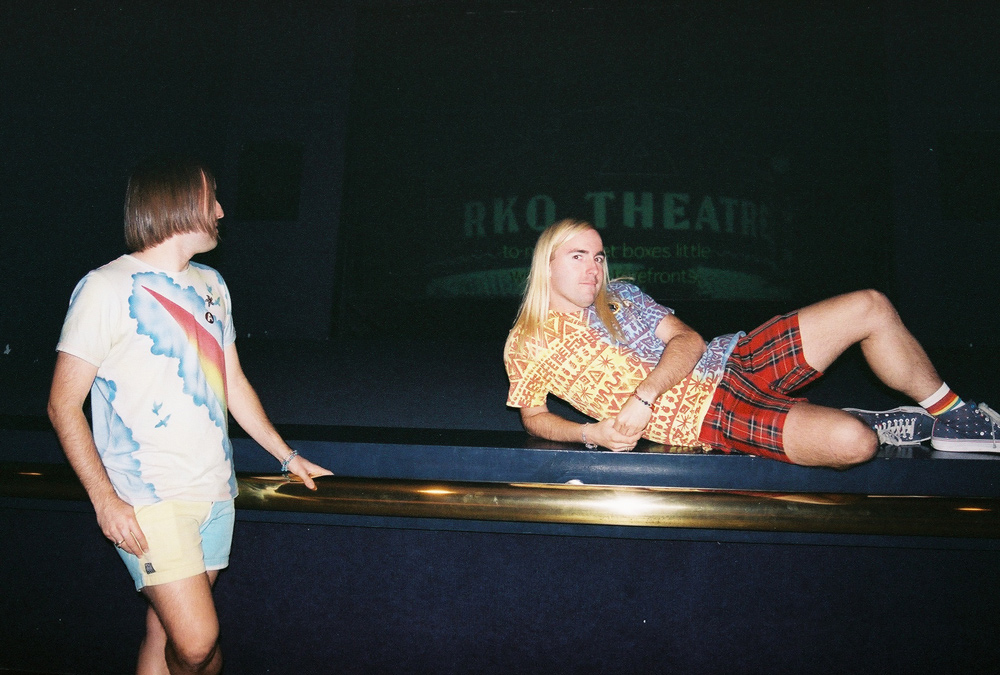
Left: Alex, Right: Philip rocking the hand-sprayed tartan.
[At your core] you guys just want people to express themselves better and you feel like Mowgli is helping people do that.
Alex: When it comes to anything that we do… I’ll walk into Urban Outfitters or see a movie or any store and be like, “You should do this, this, and this.”
Philip: It’s a positive/negative thing.
You always give people advice wherever you go?
Alex: I give people unsolicited advice constantly. Be it wrong or not. Sometimes we go into a place and we’re like, “This is cool, this doesn’t need any help.” But 99.9% of the time I’m like, “I would do this differently.” As a person, I’m never one to safeguard my opinions.
Philip: I always want to make things better, I always want to make things the best they can be. I see stuff and everything is so – to my vision – just not quite there yet.
::
Instagram: @mowglisurf
Catch the twins at Agenda Long Beach this week at Booth F31!

